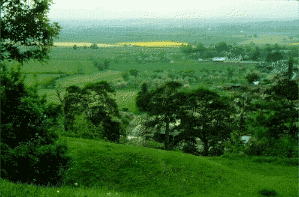

Cadbury in Somerset
Cornwall

|

|
|
Ramparts of Cadbury Castle, near South Cadbury in Somerset |
"Tintagel Island", Tintagel in Cornwall |
"The darkest of the Dark Ages" might be an apt description of the fifth and sixth centuries in Britain, a time commonly referred to as the sub-Roman period. Not dark in the sense that this era lacked character or achievement: there are certainly enough real (St Patrick) and legendary (Arthur and Merlin) associations to attract modern interests. Anyone who has investigated the history of the period behind these figures, however, soon discovers the exasperating dearth of contemporary written records. Further study only leads to historical agnosticism, and indeed it may be that we will never be able to write a narrative hitory of sub-Roman Britain.
The slack has fortunately been taken up by archaeologists. The material culture of the fifth and sixth centuries, though itself not extensive, is in many ways more accessible than the problematic written sources. At first, archaeology was used merely to supplement historical models which relied chiefly on the testimony of writers like Gildas, Bede and Nennius (see Collingwood and Myres 1936; Frere 1967; Alcock 1971). For a thorough survey of this archaeological tradition see Snyder 1994. After a profusion of source criticism began to shake these foundations (see Dumville 1977 and Snyder forthcoming) many archaeologists felt free to ignore the written record entirely and treat sub-Roman Britain as a prehistoric subject. For an example of this see Arnold 1984 and for a critique of this school of thought see Alcock 1988. The pendulum now seems to be swinging back toward the middle, with the most recent archaeological surveys of the period, such as those by Higham 1992 and Dark 1994a, attempting a balance between speculative archaeological models and careful use of the written sources.
These latest surveys are notable contributions and will undoubtedly influence the direction of future archaeological speculation. Yet there is something noticeably missing from this body of scholarship. Kenneth Dark 1994b, 67 puts his finger on it:
It is sadly true that no two modern surveys of the settlement archaeology of the period have managed to agree on a common corpus of sites ... The situation has resulted in an exceptionally unstructured data-base, chaotic in its randomness and often in the arbitrariness with which sites are included or excluded in discussion.There has, in fact, never been an attempt to present the database in a single comprehensive format. Even the most thorough of the surveys have, at best, presented only a handful of sites, and those only when they strengthen a particular argument which the author is trying to make. There are some excellent regional gazetteers (e.g. Edwards and Lane 1988 and Olson 1989, xiv, 41-45), and Dark (1994b) has himself presented much of the data in his recent work on site identification. Yet, as valuable as these resources are, they do not fill the need for a single, comprehensive reference tool for researching individual sites and settlements in sub-Roman Britian.
The Gazetteer in Part Two of this study is an attempt to fill this void. It will no doubt suffer the typical failings of first attempts at constructing an archaeological reference tool: site omissions, dated material, incomplete excavation reports. But instead of begging readers forgiveness, I shall instead extend an invitation for reader response and cooperation in the future expansion and revision of the database.
Go to the table of contents
Alcock, Leslie. 1971 Arthur's Britain: History and Archaeology AD 367-634. Penguin, New York and London
Alcock, Leslie. 1988 `The Activities of Potentates in Celtic Britain AD 500-800: A Positivist Approach' in Driscoll, S T and Nieke, M R (eds.) 1988 Power and Politics in Early Medieval Britain and Ireland Edinburgh University Press, Edingburgh, 22-46
Arnold, C.J. 1984 Roman Britain to Saxon England Indiana University Press, Bloomington, IN
Collingwood, R.G. and Myres, J.N.L. 1936 Roman Britain and the English Settlements Clarendon Press, Oxford
Dark, Kenneth R. 1994a Civitas to Kingdom: British Political Continuity 300-800 Leicester University Press, Leicester
Dark, Kenneth R. 1994b Discovery by Design: the Identification of Secular Elite Settlements in Western Britain AD 400-700 Brit. Archaeol. Rep. Brit. Ser. 237, Tempvs Reparatvm, Oxford
Dumville, David N. 1977 `Sub-Roman Britain: History and Legend' History 62, 173-92
Edwards, Nancy and Lane, Allan. 1988 Early Medieval Settlements in Wales 400-1100 University of Wales Press
Higham, Nicholas. 1992 Rome, Britain and the Anglo-Saxons Seaby, London
Frere, Sheppard. 1967 Britannia: A History of Roman Britain Routledge and Kegan Paul, London
Olson, Lynette. 1989 Early Monasteries in Cornwall Boydell Press, Woodbridge
Snyder, C. 1994 The Tyrants of Tintagel: the Terminology and Archaeology of Sub-Roman Britain (AD 400-600) unpublished PhD, Emory University
Snyder, C. 1996 Sub-Roman Britain (AD 400-600): A Gazetteer of Sites Brit. Archaeol. Rep. Brit. Ser. 247, Tempvs Reparatvm, Oxford
Snyder, C. forthcoming An Age of Tyrants: Britain and the Britons, AD 400-600 Penn State University Press, University Park PA
Last updated: Wed Sep 3 1997